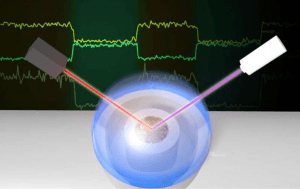 Second- and Third-order Optical Mixing: The structure and thickness of the electrical double layer are key determinants for the force required to bring dissolved species to a charged surface. However, descriptions of the structure and thickness of the electrical double layer remain largely confined to mean field theories in the form of ‘layer cake’ and ‘primitive ion’ models. Microscopic descriptions, which could lead to an increased molecular understanding, control, and prediction of interfacial phenomena over charged interfaces, remain elusive. We hypothesize that experimental measurements of the newly discovered chi(3)phase angle, 𝜑, and the subsequent quantitative analysis of the microscopic information it contains about the structure of the electrical double layer will dramatically improve our fundamental understanding of charged interfaces. The long-term prospect of testing our central hypothesis is that it will produce new microscopic insights into charged interfaces and provide benchmarks to which theory must conform.
Second- and Third-order Optical Mixing: The structure and thickness of the electrical double layer are key determinants for the force required to bring dissolved species to a charged surface. However, descriptions of the structure and thickness of the electrical double layer remain largely confined to mean field theories in the form of ‘layer cake’ and ‘primitive ion’ models. Microscopic descriptions, which could lead to an increased molecular understanding, control, and prediction of interfacial phenomena over charged interfaces, remain elusive. We hypothesize that experimental measurements of the newly discovered chi(3)phase angle, 𝜑, and the subsequent quantitative analysis of the microscopic information it contains about the structure of the electrical double layer will dramatically improve our fundamental understanding of charged interfaces. The long-term prospect of testing our central hypothesis is that it will produce new microscopic insights into charged interfaces and provide benchmarks to which theory must conform.
Selected Publications:
“Second-Order Vibrational Lineshapes from the Air/Water Interface”
Paul E. Ohno, Hong-fei Wang, James Skinner, Francesco Paesani, and Franz M. Geiger
J. Phys. Chem. A, 122, 4457-4464 and arXiv 1712.09086 (2018)
“Bulk Contributions Modulate the Sum-Frequency Generation Spectra of Interfacial Water on Model Sea-Spray Aerosols”
Sandeep K Reddy, Raphael Thiraux, Bethany A Wellen Rudd, Lu Lin, Tehseen Adel, Tatsuya Joutsuka, Franz M. Geiger, Heather C, Allen, Akihiro Morita, and Francesco Paesani
Chem, 4, 1629-1644 (2018), and ChemRxiv.5743638 (2018)
“Second-Order Spectral Lineshapes from Charged Interfaces”
Paul E. Ohno, Hong-fei Wang, and Franz M. Geiger
Nature Communications, 8, 1032 (2017)
Molecular Spectroscopy: A major recent advance in chemistry is that it is now understood that the molecular orientations of adsorbed species are critical for controlling interfacial reactivity and kinetics in heterogeneous catalysis, across lipid membranes, at separation membranes, fuel cells, etc. While much work has been carried out on understanding reactivity and kinetics on metals, vibrational studies focusing on the interaction of hydrocarbons with oxides and membranes are sparser and tend not to focus on determining the molecular orientations of the hydrocarbon species at the surface unless they are computational.
Our work contributes to closing the existing knowledge gap that currently exists with regard to the molecular orientation of hydrocarbons at oxide surfaces (SiO2, Al2O3, V2O5, WO3, MoO3to name a few) and membranes (lipids, graphene, and desalination membranes). We elucidate the molecular orientation of common saturated and unsaturated chiral and achiral hydrocarbons by assigning their vibrational surface spectra using sum frequency generation in the CH stretching region. While this frequency region is rich in information content, it is difficult to interpret using standard vibrational spectroscopy due to spectral congestion. This issue is readily overcome by taking advantage of the coherent nature of vibrational sum frequency generation, making the CH stretching region the new “fingerprinting region” for surface spectroscopy.
Selected Publications:
“Partially (resp. fully) reversible adsorption of monoterpenes (resp. alkanes and cycloalkanes) to fused silica”
Y Liu, HM Chase, FM Geiger
J. Chem. Phys. 150, 074701 (2019), Featured Article
“Orientations of Nonlocal Vibrational Modes from Combined Experimental and Theoretical Sum Frequency Spectroscopy”
Hilary M. Chase, Shunli Chen, Li Fu, Mary Alice Upshur, Benjamin Rudshteyn, Regan J. Thomson, Hong-Fei Wang, Victor S. Batista, and Franz M. Geiger
Chem. Phys. Lett., Ahmed Zewail Special Commemorative Issue (2017)
“Sum Frequency Generation Spectroscopy and Molecular Dynamics Simulations Reveal a Rotationally Fluid Adsorption State of α-Pinene on Silica”
Junming Ho, Brian T. Psciuk, Hilary M. Chase, Benjamin Rudshteyn, Mary Alice Upshur, Li Fu, Regan J. Thomson, Hong-Fei Wang, Franz M. Geiger, and Victor S. Batista
J. Phys. Chem. C, 120, 12578–12589 (2016)
“Vibrational Mode Assignment of α-Pinene by Isotope Editing: One Down, Seventy-One To Go”
Mary Alice Upshur, Hilary M. Chase, Benjamin F. Strick, Carlena J. Ebben, Li Fu, Hongfei Wang, Regan J. Thomson, and Franz M. Geiger
J. Phys. Chem. A, 120, 2684–2690 (2016)
